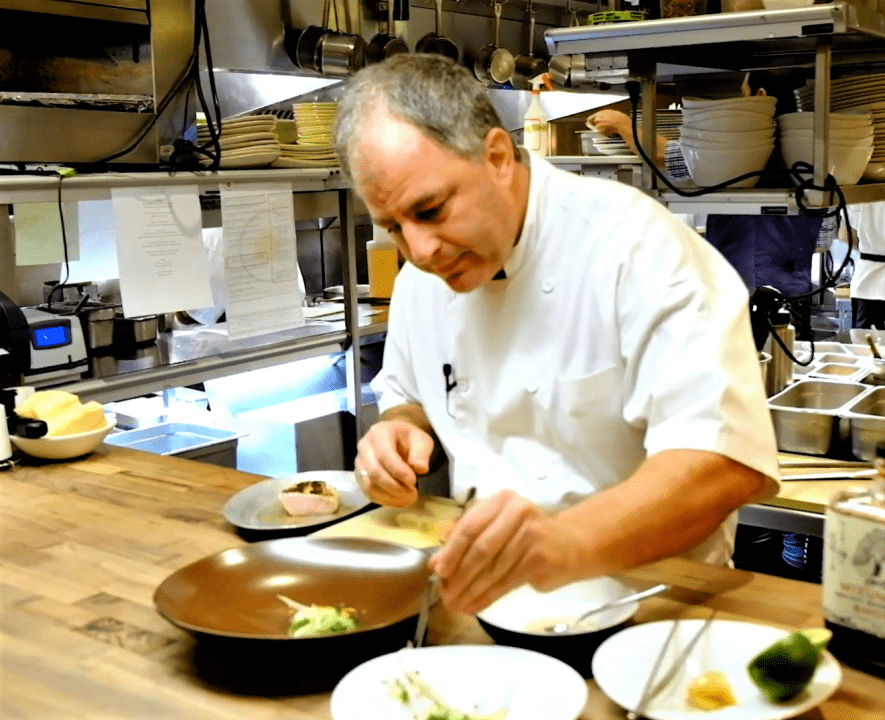Recipe for a Resilient Brand

Master Chef and Master Brand Strategist Jon Krinn at work in Clarity’s kitchen
A brand needs to be consistent yet adaptable. This can be a challenge. If your brand is not steady in its message and execution, it may not clarify your offering or distinguish your organization from your competitors. But if it is not adaptable, it may not reflect your company’s current identity.
The pandemic put effective brand management to the test for many organizations as they had to adapt quickly to deal with the consequences of the crisis. Nowhere was this more evident than in the restaurant industry. With indoor eating prohibited, restaurants, particularly fine-dining establishments, either adapted or disappeared. One chef-owner who faced this existential challenge with aplomb and strengthened his company’s brand in the process was Jonathan Krinn, owner of award-winning restaurant Clarity in Vienna, Virginia.
The Clarity brand had always been about creativity and variation — lunch and dinner menus change daily — but the pandemic put Krinn’s ingenuity and adaptability to the test. “Our base business, which had produced 100% of our income, was eliminated,” says Krinn. “I decided to create under one roof multiple new business profiles that would hopefully add up to 100% of our previous income. Five profiles at 20% or 20 profiles at 5%, each ‘situationally complementary’ to the moving target, [which was] my guests’ life situations.”
Pandemic Swivel
With indoor dining eliminated, the first inclination for most restaurateurs was to take their menu and put it in a bag. Krinn reasoned that offering takeout that was exclusively fine dining would not result in sufficient order frequency to support his business and staff.
“My guests were in shock and at home,” says Krinn. “If I were in their shoes, what kind of food would I want to eat? Comfort food.” So Krinn offered pizzas, pupusas, lasagna, pho, and chicken sandwiches in addition to his establishment’s fine-dining menu. By offering something new and different, mostly at lower price points, he stayed relevant every day of the week. The strategy paid off, generating substantial income.
Same Clientele. Different Journey.
Krinn stayed top of mind by continuously communicating with his clientele through social media. Taking his cue from the movie industry, Krinn would preview each new offering with a compelling story, build anticipation, and then roll it out, creating positive emotional connections in a time dominated by bad news and negativity. Each new offering was presented for a limited time, and then he would move on, so the concepts needed to keep coming. He bought a competition-grade smoker, and suddenly Clarity was also a barbecue joint. He also invested in an Argentinian grill and added grilled items to the menu.
Spring Forward
When the weather broke, Krinn turned his parking lot into a restaurant — but for $200 tasting menus only, to recoup some of the revenue lost in the winter. His challenge was transforming his 52-space parking lot into a dining venue worthy of his pricing while still being able to offer parking for guests’ cars. Using alternating parking spaces to ensure social distancing, Krinn created 26 “private dining campsites,” each with a tent covering not only guests’ car but also their dining table. With childcare unavailable, kids even sat in the open backs of SUVs with pizza and their own electronic devices beside their parents. The format sold out for four months.
Six Restaurants in One
In the fall, Krinn opened an oyster bar and an outdoor “bring your own cigar” lounge. Clarity now had six profiles under one roof: its a la carte menu, tasting menu, barbecue, a grill, oyster bar, and cigar lounge. Winter brought additional income streams: virtual wine dinners, cooking classes, and even knife-sharpening services for home chefs.
Krinn then turned his attention to generating opportunities for others, as an outbreak necessitated a more prolonged shutdown of DC. Krinn created “A Taste of DC in Virginia,” a sold-out takeout event featuring dishes made by six DC chefs in a package that Krinn sold to Clarity’s clientele, with proceeds going back to the chefs who were involved. Based on that success, Krinn initiated six sold-out “Guest Chefs at Clarity” evenings, each featuring a new DC chef and their own menu executed at Clarity, again with the proceeds going to each chef.
A Stronger Brand
Clarity emerged from the pandemic as a more vital organization, and Chef Krinn retained his entire staff of 80, all fully paid. Krinn’s creativity, extensive press coverage, and positive social media presence significantly increased the restaurant’s client base.
Moving forward, the lessons learned during the pandemic will serve Clarity well no matter what the future brings. Krinn cemented his reputation throughout the greater Washington, DC, restaurant community as the “pivoter in chief.” And Clarity’s core brand themes of creativity and variation were positively reinforced by the restaurant’s continual adaptation to evolving community and market conditions.
These lessons learned are also extendable to the business community at large. When facing constraints around core market offerings, firms must evaluate and trade-off strategies for broadening both their product offerings (e.g., ranging from comfort food to oysters), and their service offerings (e.g., ranging from takeout to knife sharpening). Care must be taken when “adding the spices” of additional new business profiles not to overwhelm or dilute the essential ingredients of the business. All the while, communications have to be effective to make sure that current and potential customers and other stakeholders are maintaining and building their appetite for these offerings. In this instance, the chef clearly had the right recipe for Clarity and may very well be able to blend his culinary skills and management consulting background to help other businesses think more adaptively about necessary pivoting in their own respective markets.